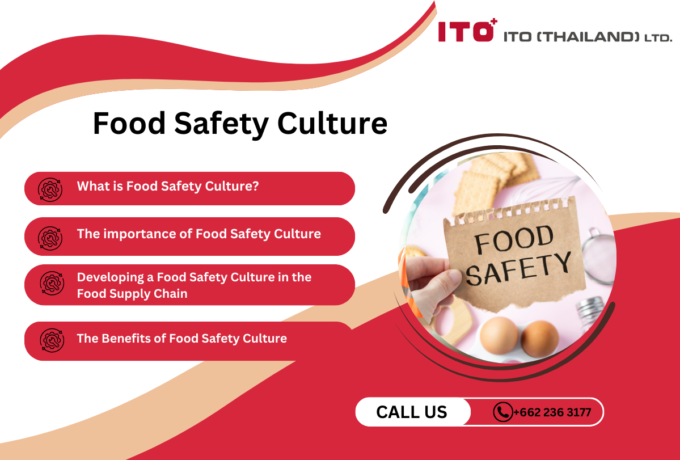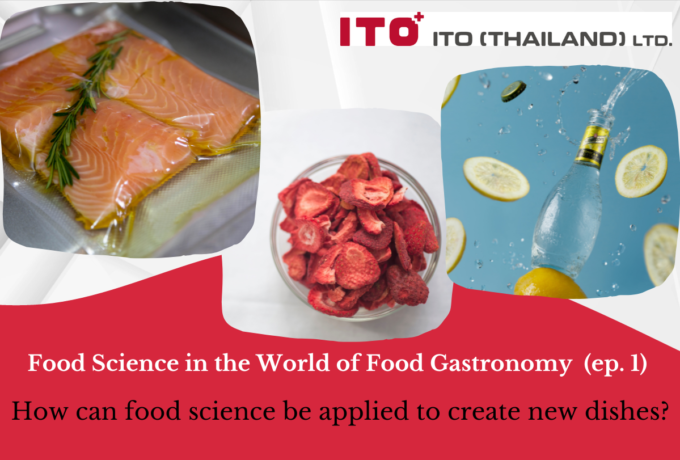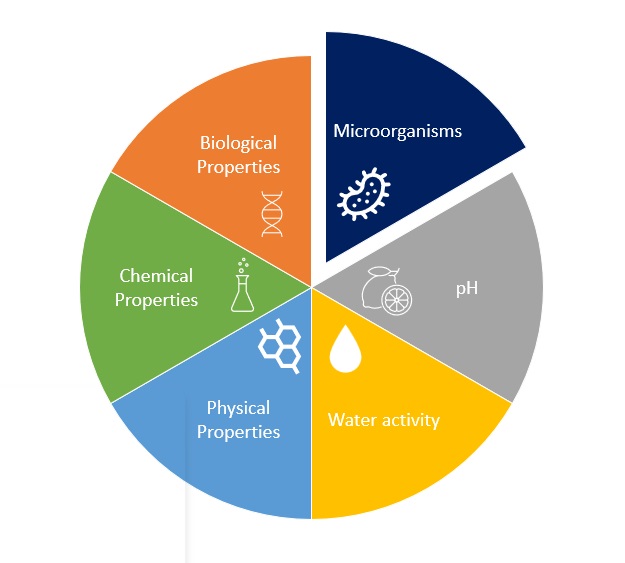ITO Thailand Hygiene Blog
Factors affecting the shelf life of food (Part 1: Internal factors)
Labeling shelf life of food
Labeling shelf life of food will depend on 2 parts: food safety and maintaining good quality. For safety, food will go bad, often referred to as “expired”, when it is no longer safe such as the growth of pathogenic microorganisms or the accumulation of more toxic substances than the amount required by law. For good quality, it means the satisfaction of consumers, whether it is smell, taste, texture, must be accepted by consumers including various nutritional qualities or functions as stated on the product label. If food quality is not as specified or consumers do not accept although it can be eaten safely, it is considered that the food has passed the time of good quality, which is indicated on the label as the time interval “Best Before.”
Why does food change in quality or deteriorate?
Most deterioration in the quality or safety of the food is caused by chemical or biochemical reactions in food. This may be due to the composition of the food itself, such as the interaction between the fats in food and the air that causes rancidity, the degradation of the fruit structure due to fruit enzymes that soften the fruit, dehydration of leaf vegetables, pigment fading due to light, browning reaction between sugars and amino acids and so on, or biological reactions of microorganisms left in the atmosphere and on food particles such as growth of pathogens, production of flavoring agents, production of microbial acid, growth of fungi that can be observed on food surfaces and so on. Besides, there is also some deterioration caused by physical mechanisms such as the movement of water molecules in and out of the structure, arrangement of crystal structures and so on.
6 Internal factors that cause deterioration in food
Each food has a different composition and structure. This makes the reactions that occur in food vary as well. Controlling the rate of deterioration of food products may be done by improving the formula or setting the specification of raw materials for the food to have a shelf life as needed. The five main factors causing deterioration in food are as follows:
1.pH
pH in food, in addition to affecting the taste, also affects the chemical, biochemical and physical reactions of food and the growth of microorganisms in the food. Chemical reactions of substances in food or biochemical reactions of many types of enzymes will have a reaction rate depending on the pH of the product, such as the decomposition of pigments in food (1) (such as chlorophyll, carotenoids, anthocyanins), protein denaturation (such as curd formation of fermented milk), browning between sugars and amino acids, function of enzymes that changes the molecular structure of food (such as pectins, carbohydrates, proteins, fats), including affecting the gel formation of some hydrocolloids and crystallization characteristics of sugars or other carbohydrate molecules.
In terms of microorganisms, pH affects the survival and growth of each type of microorganism. Highly acidic foods have lower microbial survival. For example, Clostridium botulinum cannot grow at pH below 4.6(2) Therefore, Good Hygiene Compliance (GHP) standard has additional specific requirements for low-acid and acid-modified foods due to the higher risk of the growth of microorganisms.
2.Water activity
The reactions within the food that spoil the food require the movement of molecules. Thus, if molecules move more easily, the reaction rate will be faster, which means food will deteriorate faster too. One factor that makes molecules move more easily is water molecules which is shown in the form of Water activity: Aw in food that acts like a lubricant for molecules to move, react more easily as well as making food to have the appropriate conditions for the growth of microorganisms. Perishable food such as meat, vegetables, fruit, milk, bread, and so on has Aw> 0.85, intermediate moisture food has Aw between 0.6-0.84, and dehydrated food has Aw < 0.6 (3)
3.Physical properties
Physical properties of food, for example, are structure, status change properties, crystallization level and so on. In addition to directly affecting the texture of food, both solid and liquid, it also affects the rate of food deterioration because the structure of the food may support or hinder the reaction that deteriorates the food. For example, smaller powdered sugars have a greater overall surface area than larger sugar crystals. This makes it more likely to react with the humidity in the air. Foods that are very viscous can slow down chemical reactions because the reactant molecules cannot react with each other, or the fiber structure in the bran portion of brown rice makes it harder for enzymes to digest than white rice.
4.Chemical properties
The chemical properties of food directly affect the chemical reactions in the food, including type of reactants, concentration, solubility and solvents. Properties of reactivity including substances that catalyst and inhibit other reactions all affect the deterioration of food. For example, polyunsaturated fat (its structure has many double bonds) will undergo oxidation with oxygen in the air and will easily become rancid. However, if other substances with more oxidative properties than fats are added, these substances will resist the deterioration of fat by competing and reacting with air instead. (4) In addition, some substances have the effect of inhibiting the growth of microorganisms, which can reduce the rate of deterioration from microorganisms.
5.Biological properties
Biological properties of food such as plant respiration, function of food enzymes, is another factor that causes food to deteriorate. Certain enzymes are naturally present in food and cause changes in the food over time. For example, Pectinase that is naturally present in fruits and vegetables softens the pectin structure of fruits and vegetables over time. Some enzymes are activated when exposed to air. For example, Polyphenol oxidase reacts with oxygen in the air causing browning in some fruits (such as apples) and melanosis in shrimp. Peroxidase and Lipase cause fat to react with oxygen, which produces a rancid smell and so on.
6.Microorganisms in food
The type and amount of microorganisms in the food left after microbial reduction process (such as washing, heating, irradiation) will affect the rate of deterioration of the food. Food products that have much microorganisms (may be caused by contamination or insufficient cleaning of the production area, elements in the food contributing to the survival of the microorganism or the process of reducing the amount of microorganisms is not appropriate) have a high chance that microorganisms will grow until the amount exceeds the legal limit and not safe for consumers. Or microorganisms in food may form compounds that affect food quality, such as abnormal sour taste from acids produced by microorganisms, bad smell, abnormal color, fungal net structure and so on.
References
1.Andrés-Bello, A., Barreto-Palacios, V. I. V. I. A. N., García-Segovia, P., Mir-Bel, J., & Martínez-Monzó, J. (2013). Effect of pH on color and texture of food products. Food Engineering Reviews, 5(3), 158-170.
3.Hazard Analysis and Risk-Based Preventive Controls for Human Food: Draft Guidance for Industry [online]. https://www.fda.gov/media/99572/download
4.Domínguez, R., Pateiro, M., Gagaoua, M., Barba, F. J., Zhang, W., & Lorenzo, J. M. (2019). A comprehensive review on lipid oxidation in meat and meat products. Antioxidants, 8(10), 429.
Related Post
-

Food Safety Culture
Food safety culture plays a crucial role in safeguarding the company's reputation, ensuring the well-being of its employees, and providing a safe experience for its customers.
-

New food source safety issues
What are safety issues worth knowing for trendy new food sources like plant-based and insect-based proteins?
-

British Retail Consortium (BRC) Standard
Food safety management systems play a vital role in ensuring the production and distribution of safe and high-quality food products to consumers. With the global food supply chain becoming increasingly complex, food businesses must implement effective systems prioritising safety, quality, and compliance with industry standards. A food safety management system encompasses a set of procedures, processes, and controls designed to identify, prevent, and manage potential hazards at every stage of the food production and supply process. This proactive approach not only safeguards consumers' health but also protects the reputation and credibility of food companies in an ever more competitive market.
-

Food Science in the World of Food Gastronomy (Part 1)
How can food science be applied to create new dishes?
-

FSSC 22000
Food manufacturers must ensure food safety standards and processes. FSSC 22000 is an official certification program for Food Safety Management Systems (FSMS) recognised by the Global Food Safety Initiative (GFSI). This certification scheme offers a set of guidelines and procedures to ensure uniformity, openness, and safety across your entire supply chain. It applies to all companies operating within the food and beverage industry, ranging from farmers to retailers. By fulfilling the necessary criteria and obtaining FSSC 22000 certification, it is demonstrated that the required standards for food quality and implementing effective processes to manage and mitigate risks associated with food fraud, foodborne illnesses, expensive recalls, and other external threats are met.
-

Food Safety Aspects of Artificial Sweeteners
Artificial sweeteners, also known as sugar substitutes, non-nutritive sweeteners, or high-intensity sweeteners, are artificially produced compounds utilised in place of sucrose (table sugar) to add sweetness to food and drinks. Due to their significantly higher sweetness than regular sugar, only a fraction of artificial sweeteners (200 to 20,000 times less) is required to achieve an equivalent level of sweetness. Since the caloric contribution of these sweeteners, when used in such small quantities, is insignificant, they are often referred to as non-nutritive (4).










